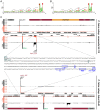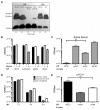Comparative genome analysis of Campylobacter fetus subspecies revealed horizontally acquired genetic elements important for virulence and niche specificity
- PMID: 24416416
- PMCID: PMC3887049
- DOI: 10.1371/journal.pone.0085491
Comparative genome analysis of Campylobacter fetus subspecies revealed horizontally acquired genetic elements important for virulence and niche specificity
Abstract
Campylobacter fetus are important animal and human pathogens and the two major subspecies differ strikingly in pathogenicity. C. fetus subsp. venerealis is highly niche-adapted, mainly infecting the genital tract of cattle. C. fetus subsp. fetus has a wider host-range, colonizing the genital- and intestinal-tract of animals and humans. We report the complete genomic sequence of C. fetus subsp. venerealis 84-112 and comparisons to the genome of C. fetus subsp. fetus 82-40. Functional analysis of genes predicted to be involved in C. fetus virulence was performed. The two subspecies are highly syntenic with 92% sequence identity but C. fetus subsp. venerealis has a larger genome and an extra-chromosomal element. Aside from apparent gene transfer agents and hypothetical proteins, the unique genes in both subspecies comprise two known functional groups: lipopolysaccharide production, and type IV secretion machineries. Analyses of lipopolysaccharide-biosynthesis genes in C. fetus isolates showed linkage to particular pathotypes, and mutational inactivation demonstrated their roles in regulating virulence and host range. The comparative analysis presented here broadens knowledge of the genomic basis of C. fetus pathogenesis and host specificity. It further highlights the importance of surface-exposed structures to C. fetus pathogenicity and demonstrates how evolutionary forces optimize the fitness and host-adaptation of these pathogens.
Conflict of interest statement
Figures






Similar articles
-
Genomic analysis of Campylobacter fetus subspecies: identification of candidate virulence determinants and diagnostic assay targets.BMC Microbiol. 2009 May 8;9:86. doi: 10.1186/1471-2180-9-86. BMC Microbiol. 2009. PMID: 19422718 Free PMC article.
-
A genomic island defines subspecies-specific virulence features of the host-adapted pathogen Campylobacter fetus subsp. venerealis.J Bacteriol. 2010 Jan;192(2):502-17. doi: 10.1128/JB.00803-09. Epub 2009 Nov 6. J Bacteriol. 2010. PMID: 19897645 Free PMC article.
-
Campylobacter fetus subspecies: comparative genomics and prediction of potential virulence targets.Gene. 2012 Oct 25;508(2):145-56. doi: 10.1016/j.gene.2012.07.070. Epub 2012 Aug 6. Gene. 2012. PMID: 22890137
-
So close and yet so far - Molecular Microbiology of Campylobacter fetus subspecies.Eur J Microbiol Immunol (Bp). 2012 Mar;2(1):66-75. doi: 10.1556/EuJMI.2.2012.1.10. Epub 2012 Mar 17. Eur J Microbiol Immunol (Bp). 2012. PMID: 24611123 Free PMC article. Review.
-
New molecular microbiology approaches in the study of Campylobacter fetus.Microb Biotechnol. 2011 Jan;4(1):8-19. doi: 10.1111/j.1751-7915.2010.00173.x. Microb Biotechnol. 2011. PMID: 21255368 Free PMC article. Review.
Cited by
-
Living in Cold Blood: Arcobacter, Campylobacter, and Helicobacter in Reptiles.Front Microbiol. 2019 May 15;10:1086. doi: 10.3389/fmicb.2019.01086. eCollection 2019. Front Microbiol. 2019. PMID: 31191467 Free PMC article. Review.
-
Homologous Recombination between Genetically Divergent Campylobacter fetus Lineages Supports Host-Associated Speciation.Genome Biol Evol. 2018 Mar 1;10(3):716-722. doi: 10.1093/gbe/evy048. Genome Biol Evol. 2018. PMID: 29608720 Free PMC article.
-
Uncovering the boundaries of Campylobacter species through large-scale phylogenetic and nucleotide identity analyses.mSystems. 2024 Apr 16;9(4):e0121823. doi: 10.1128/msystems.01218-23. Epub 2024 Mar 26. mSystems. 2024. PMID: 38530055 Free PMC article.
-
Evaluation of intracellular survival of Campylobacter fetus subsp. fetus in bovine endometrial cells by qPCR.Iran J Vet Res. 2021 Spring;22(2):94-99. doi: 10.22099/ijvr.2021.38693.5632. Iran J Vet Res. 2021. PMID: 34306105 Free PMC article.
-
Fic Proteins of Campylobacter fetus subsp. venerealis Form a Network of Functional Toxin-Antitoxin Systems.Front Microbiol. 2017 Oct 17;8:1965. doi: 10.3389/fmicb.2017.01965. eCollection 2017. Front Microbiol. 2017. PMID: 29089929 Free PMC article.
References
-
- Man SM (2011) The clinical importance of emerging Campylobacter species. Nat Rev Gastroenterol Hepatol 8: 669–685. - PubMed
-
- van Bergen MA, Simons G, van der Graaf-van Bloois L, van Putten JP, Rombout J, et al. (2005) Amplified fragment length polymorphism based identification of genetic markers and novel PCR assay for differentiation of Campylobacter fetus subspecies. J Med Microbiol 54: 1217–1224. - PubMed
Publication types
MeSH terms
Substances
Grants and funding
LinkOut - more resources
Full Text Sources
Other Literature Sources
Molecular Biology Databases

